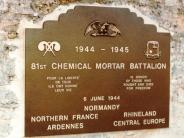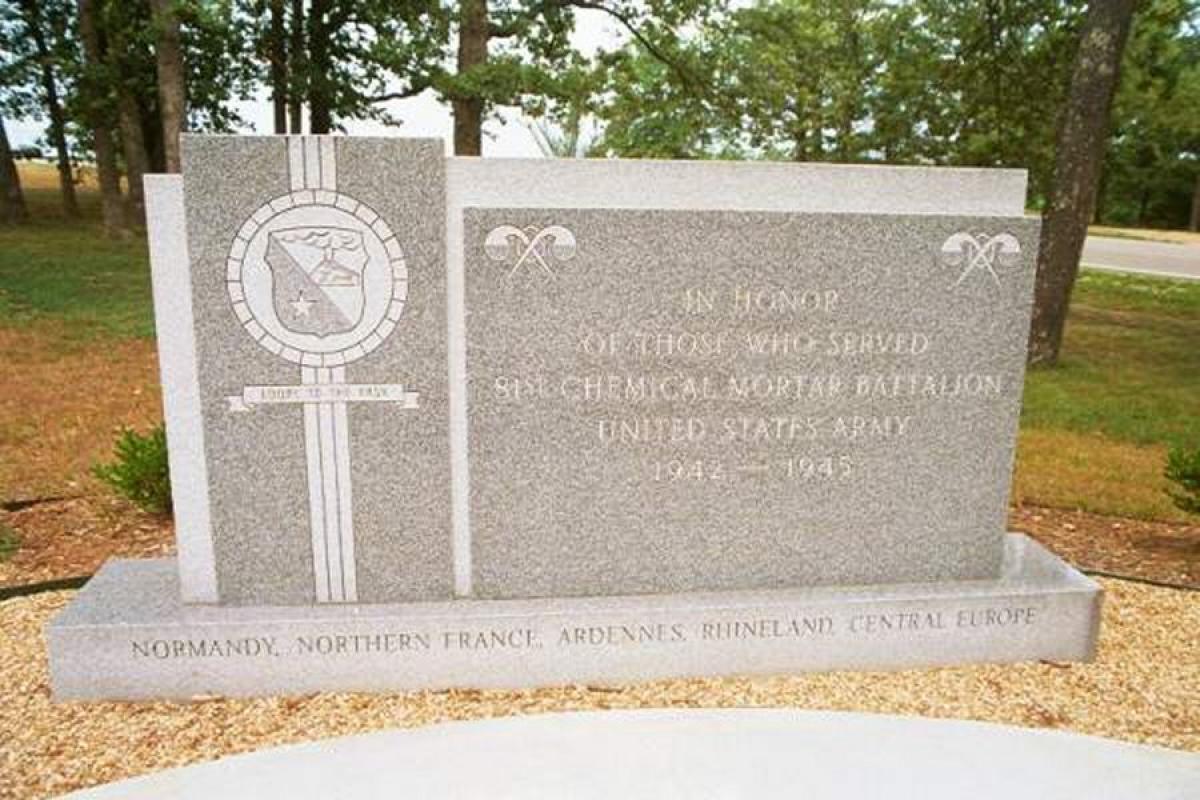

U. S. ARMY 81ST CHEMICAL MORTAR BATTALION – The 81st Chemical Battalion (Motorized) was constituted March 12, 1942 as an inactive unit and made active at Fort D. A. Russell, Texas on April 25, 1942 under the command of Lt Col Thomas James.
On 10 March 1943 General Keating told the assembled officers of the Center that the future of the organization was very much in doubt and that it appeared probable that no more training would be conducted at Camp Gordon Johnston. General Keating kept in close touch with Army Ground Forces by telephone regarding the status of the Center, and early in April he was notified verbally that the Center was soon to be disbanded. In compliance with these directives, training aids were torn down and salvaged or shipped to other camps in the country, a large amount of property was either turned in to the post supply agencies or shipped in accordance with Army Ground Forces directive.
Early in May, after all training aids had been removed, key officers transferred, and the Center generally rendered incapable of further operation as such, three separate battalions arrived at Camp Gordon Johnston for basic amphibious training. These were the 81st Chemical Battalion, the 61st Medical Battalion, and the 462d AAA AW Battalion. The school was hastily reorganized by pressing into service officers who had not served before as instructors, and an abbreviated course of basic amphibious training was given to these battalions. Fortunately the cargo-net towers had not been torn down, but the nets had to be re-erected and considerable work in addition was required to restore the obstacle courses, battle courses, etc., to an operating condition. There were no boats available because the boat-operating unit had previously been ordered away.
THE AMPHIBIOUS TRAINING CENTER Study No. 22 By Capt. Marshall O. Becker;
https://history.army.mil/books/agf/AGF22/amphib-fm.htm
Amphibious Maneuvers at Camp Gordon Johnston, Florida
On May 6, 1943, the 81st arrived at Camp Gordon Johnston, Carrabelle, Florida, for participation in amphibious commando and physical training. The battalion was attached to the 28th Division for administrative purposes during its stay there. The program was vigorous, hazardous and exciting, and several fell by the wayside due to the rapid pace and constant exertion under the hot, tropical Florida sun.
The program consisted of combat swinging, speed marches, unorthodox exercises (and we do mean unorthodox), street fighting, Judo, hand-to-hand fighting, use of knife and bayonet, cargo net practice on mock-ups, loading and unloading in small craft, demolitions, and the use of explosives. The battalion also had its first taste of the infiltration course at this time. The attack on Schicklgruber village with live ammunition furnished plenty of excitement and firsthand experience in street fighting and battle sounds.
Trips to Tallahassee, beach parties, and other extra-curricular activities took the curse off this particular period, but no one was sorry when orders came to leave the place that Winchell had dubbed “The Alcatraz of the Army.” Every man that came through that training will admit, however, that he was in better physical shape for it. The battalion departed from this station on June 9-10, 1943.
Departed the New York Port October 21, 1943 and arrived in England November 2, 1943. Committed to combat in the European Theater of Operations and landed on Omaha Beach, France on June 6, 1944. Assigned to the First Army. Served in Belgium (date unknown) Redesignated February 22, 1945 as the 81st Chemcial Mortar Battalion. The date the unit entered Germany is unknown. The unit was at Branau, Germany at the end of World War II (August 15, 1945 location). Served in the Army of Occupation of Germany from May 2 – August 14, 1945. Returned to the United States in September, 1945. via the New York. Inactivated November 7, 1945 at Fort Leonard Wood, Missouri.
CAMPAIGN PARTICIPATION CREDIT: Normandy (with arrowhead) Northern France Rhineland Ardennes-Alsace Central Europe
DECORATIONS: Distinguished Unit Citation (Unit cited for period 6-18 June 1944 per WD GO 73-1944)
COAT OF ARMS SHIELD: Per bend or and azure, in chief a volcano peak sable errupting smoke throughout proper, in base a mullet argent.
MOTTO: Equal to the Task.
SYMBOLISM: In the blue and yellow of the Chemical Warfare Services the volcano symbolizes the nearest approach in nature to modern chemical warfare agents, viz; smoke, incendiaries, harassing fumes and casualty producing gases; the lone star is symbolic of the state of Texas, in which the 81st Chemcial Battralion was activated and served at its first permanent station.
WWII Commands: 81st Chemical Mortar Battalion
Eric B. Greisinger
DESIGNATION: Company A, 81st Chemical Mortar Battalion
ACTIVATION: April 24, 1942
The 81st Chemical Battalion (Motorized), later designated the 81st Chemical Mortar Battalion, was activated on April 24, 1942, as one of the small specialized groups being raised quickly to fill gaps in the burgeoning U.S. Army.
Following a period of intense training, the 81st arrived at Camp Shanks, N.Y., for processing and overseas deployment on October 15, 1943. It arrived in Liverpool, England, on November 2 and spent the winter honing its amphibious skills in preparation for the invasion of Nazio-ccupied France. In late April 1944, the 81st was attached to the 1st Infantry Division.
In mid-May, the battalion was sent to its marshaling area in Dover, where it was divided into separate companies to support specific units. Company A was attached along with Company C to the 16th Regimental Combat Team.
At 0430 hours on June 6, all companies of the battalion were off-loaded onto LCVPs 15 miles from their designated landing beaches. It was nearly three hours later when the company landed on the Easy Red sector of Omaha Beach beside the 2nd Battalion, 16th Infantry.
The beach was a tableau of chaos. Heavy seas had caused much of the company’s equipment to sink to the bottom of the English Channel, though a handful of intrepid soldiers had done what they could to recover some of it.
Pinned to the beach under a hail of machine gun fire, Captain Thomas Peter Moundres, the company commander, was mortally wounded. He was dragged ashore by 1st Lt. James P. Panas, who had already pulled a wounded GI onto the beach and had assumed command.
Panas then moved the company to a firing position on the bluffs above the beach. When the infantry broke through later in the day, those positions were moved 500 yards from the beach to a spot near a tank trap, where the men came under a heavy barrage.
After D-Day, the battalion pushed inland and took part in the assault on St. Lô. Company A was given nightly harassing fire schedules, as well as supporting infantry attacks on Hill 192, during which it fired 500 rounds in a 14-hour period.
In early August, the 81st reassembled for its first formal rest period. Following the hiatus, Company A was attached to the 175th Infantry, 29th Division, and moved swiftly through the Vire River valley. The battalion also assisted in bridging the lower half of the Falaise pocket, which helped seal the fate of the German Seventh Army.
Following a brief rest, the entire battalion took part in the Allies’ race to Paris. On the outskirts of the “City of Light,” the companies were again split up, and after crossing the Seine, Company A moved on to Germany.
In early September, Companies A and B were attached to the 4th Division. It was with the men of the “Ivy” Division that Company A reached the Meuse River. Eight days after crossing the Meuse, Company A finally set foot on German soil. The next day, its 4.2-inch mortars joined with those of Company B in shelling the Siegfried Line, as 4th Division GIs made their first assaults on that formidable defensive belt.
Shortly thereafter, the entire battalion was transferred to Lt. Gen. George S. Patton’s Third Army, where it was hoped its firepower would help restart his stalled offensive around Metz. Company A supported the “Tough Hombres” of the 90th Division as they attacked the city from the north.
On October 8, the company was moved south of Hagondange to assist the 357th Infantry in taking Maizières-les-Metz. The attack quickly turned into a bitter slugfest, and remained so for nearly a month.
At 0350 hours on November 14, Company A crossed the Moselle River and proceeded to Valmestroff, enduring heavy fire and suffering several casualties.
After Metz fell, Company A moved into the Saar Basin. It arrived at Gomelange near the Neisse River on November 24. The company was then attached to the 377th Infantry. On November 29, it entered Germany again near Saarlauten.
When the Germans launched their Ardennes offensive on December 16, much of the Third Army began moving north toward Bastogne, leaving some units such as Company A to hold the line.
After stopping the Germans in the Ardennes, the Americans resumed the offensive toward the Saar-Moselle triangle. During that operation, Company A remained in Saarlauten. On January 29, it was attached to the 102nd Field Artillery Battalion, 26th Infantry Division.
By March 1945, the drive for the Rhine was underway, and Company A moved on the 12th to an area five miles east of Saarburg to support the 80th Division. The infantrymen were punching a hole to allow the 14th Armored Division through and either to trap the Germans on the Rhine River or push them to the opposite bank.
By March 16, the attack was moving with regularity again, and the German retreat turned to a rout, causing Company A to move several times a day to keep pace. On the 19th the Germans were at the Rhine under heavy aerial attack.
Two days later, however, the company suffered its hardest day. While standing in line for breakfast, the men were strafed by enemy aircraft. Within 10 minutes, 40 had been wounded and three killed.
In late April, the battalion took part in mop-up operations in Austria. By April 5, Company A had passed Kassel. Most nights for the company were spent in houses and beds, and for the next four days there were no missions on the German side of the Rhine. After the brief respite, the company resumed its advance, until it reached Chemnitz on April 16.
Two days later, after an all-night push, the company rendezvoused with the 71st Infantry Division at Bamberg. The following day, it fired onto the shore of the Danube in support of an infantry crossing.
On May 2, the company crossed the Enns River. After spotting the Germans digging in, it fired nine rounds of high explosives and laid a smokescreen for others crossing behind them. Those were the last rounds fired from Company A’s 4.2- inch mortars during the war.
Originally published in the October 2006 issue of World War II.
A more detailed book of this unit’s history is available in electronic form. (off site link)
